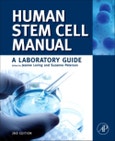This manual is a comprehensive compilation of "methods that work" for deriving, characterizing, and differentiating hPSCs, written by the researchers who developed and tested the methods and use them every day in their laboratories. The manual is much more than a collection of recipes; it is intended to spark the interest of scientists in areas of stem cell biology that they may not have considered to be important to their work. The second edition of the Human Stem Cell Manual is an extraordinary laboratory guide for both experienced stem cell researchers and those just beginning to use stem cells in their work.
- Offers a comprehensive guide for medical and biology researchers who want to use stem cells for basic research, disease modeling, drug development, and cell therapy applications
- Provides a cohesive global view of the current state of stem cell research, with chapters written by pioneering stem cell researchers in Asia, Europe, and North America
- Includes new chapters devoted to recently developed methods, such as iPSC technology, written by the scientists who made these breakthroughs
Table of Contents
Part I: Basic methods: Maintenance of stem cell cultures 1.Human Embryonic Stem Cell Culture 2.Feeder layers and feeder-free culture 3.Mouse Embryonic Fibroblast Feeder Cells 4.Cryopreservation of hESC
Part II: Basic methods: Characterization of stem cells 5.Classical Cytogenetics: Karyotyping 6.Spectral Karyotyping and Fluorescent in situ Hybridization 7.Using SNP Genotyping to Identify Cell Lines, Determine Genomic Abnormalities and Monitor DNA Methylation Patterns 8.FACS/Cell sorting 9.Fluorescence Immunocytochemical Analysis of Stem Cells 10.Characterization of Stem Cells Using RT-PCR 11.Gene Expression Profiling of Stem Cells by Microarray 12.Teratomas produced from Human Embryonic Stem Cells Xenografted into Immunodeficient Mice 13.Generation of HESC-Derived Teratomas
Part III: Differentiation of stem cells 14."Embryoid Body Formation and Neuroepithelia Differentiation 15.Motor Neuron and Dopamine Neuron Differentiation 16.Oligodendrocyte Differentiation from hESC 17.Cardiac 18.Hematopoietic
Part IV: Genetic manipulation of stem cells 19.Genetic Manipulation of hESC: Lentivirus Vectors 20.Methods developed for mouse ES cells
Part V: Advanced methods 21.Derivation of human ES cells 22.Neural Stem Cell Culture 23.Transplantation of stem cells 24.In vitro fertilization 25.Functional characterization-neural cells
Part VI: Practical issues in establishing a human ES cell laboratory 26.Setting Up a Facility for hESC Research
Part VII: Essays on stem cell biology 27.Intellectual Property: Owning the Stem Cell 28.Ethical Concerns for Stem Cell Research 29.Guidelines for hESC Research Oversight (ESCRO) Committees








